|
|
Railroad
Police Badges
Railroad police used a special style of badge. Unlike
cap badges (see badge page) that were used by
most railroad occupations, railroad police badges were similar to those
used by civil law enforcement. This reflected the fact that railroad
police were (and are) bona fide law enforcement officers, as defined
under state laws. Many railroad police badges have a "star" or "shield" shape
and are generally marked for the railroads on which they were used. Like
other railroad badges, railroad police badges are very popular as collectibles
and relatively easy to produce, so they have become particularly susceptible
to counterfeiting. Modern reproductions have been made by the thousands,
and many if not most of these are not clearly marked as reproductions.
Therefore, collectors need to be especially careful and knowledgeable
to avoid being duped.
Here are some especially nice railroad police badges, all
but one of which are definitely authentic. Note that most of these show
evidence of wear and patina, which would be expected after years of hard
service. Unless otherwise noted, these badges are from the collection
of Bill Kajdzik who generously provided the digital scans (Thanks, Bill!).
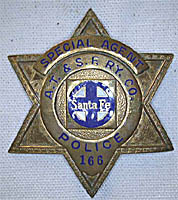 |
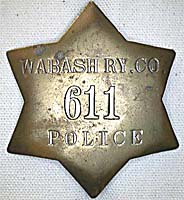 |
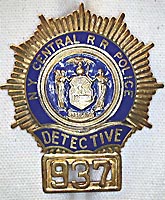 |
| A "Special Agent" 6-sided star
badge from the Atchison, Topeka & Santa Fe Railway. |
A Police badge from the Wabash Railway. |
A Detective badge from the New York Central
Railroad. |
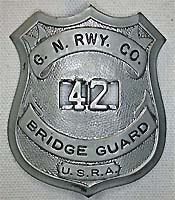 |
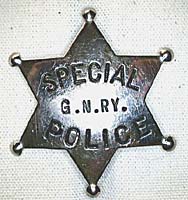 |
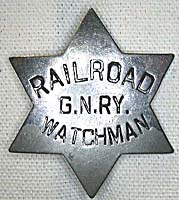 |
| A Bridge Guard badge from the Great Northern
Railway. Click for a larger view. |
A Special Police badge from the Great
Northern Railway. |
A Watchman badge from the Great Northern
Railway. |
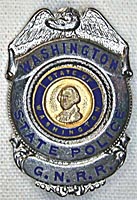 |
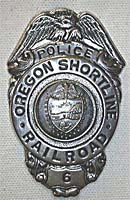 |
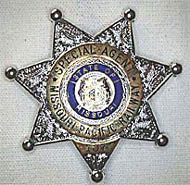 |
| A badge marked for both the Washington
State Police badge and the Great Northern Railway. See comments. |
A Police badge from the Oregon Shortline
Railroad. |
A Special Agent badge from the Missouri
Pacific Railroad. |
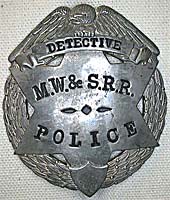 |
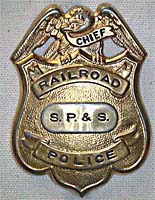 |
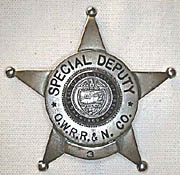 |
| A Detective badge possibly from the Montana,
Wyoming & Southern Railroad. |
A Police Chief badge from the Spokane,
Portland & Seattle Railway. |
A Special Deputy badge from the Oregon,
Washington Railroad & Navigation Company. |
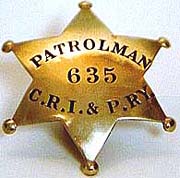 |
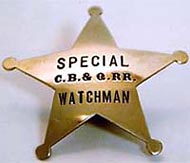 |
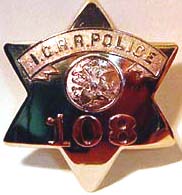 |
| A patrolman's badge from the Chicago,
Rock Island & Pacific Railway. The "Rock Island" issued
many different designs of badges over the years, from large Chicago
Police Style "pie plates" to these small six pointed ball
tip stars. Because of the patina on the front of this badge
and the tarnish on the back, it's probably authentic. Phil O'Keefe
collection. |
A Special Watchman Badge from the
Chicago, Burlington & Quincy Railroad. It has no number
and was probably issued to special employees hired to assist railroad
policemen during times of war. Although the badge is shiny on the
front, the back is tarnished and old looking, so it's probably the
genuine article. It is hallmarked “J P Cooke Co. Mfr’s
Omaha." Phil O'Keefe collection. |
A large Chicago Police Style "pie
plate" badge of the type used by the Illinois Central Railroad's
Special Agent Division from the 1920's to the late 1960's. The
3 1/2" diameter badge has applied copper numerals and an Illinois
State seal in the center. Phil O'Keefe, who provided this photo
notes that although it is hallmarked "The C.H. Hansen Co. -
Chicago", there is the possibility that it may be a modern remake
struck from the original tooling. Phil O'Keefe collection. |
Comments. We received the first following comment in December, 2007 regarding the Washington State Police badge shown above, third row, far left. Below that is a comment received on Novermber 27, 2022.
First of all, there was never a "Washington State Police". In 1921 there was the "highway police" but in 1931, it was officially named the "state patrol". In the 70's I was a local police officer in rural Washington and a part-time U.P. watchman working on an anti-theft detail in Wenatchee, WA. I was given a badge that read "Special State Police" with a Washington State seal and the initials "UPRR" on the bottom, much like the badge your site has. Now to the history: RR police received a special commission from the governor and the whole affair was somewhat lax. No training was required nor was a ID or badge issued, only a commissioning letter. (I never had a "commission" as a RR cop as I had my local police commission which was good throughout the state). RR cops often carried two badges. An official one from the RR in their wallets and the "state police" badge which they showed people.The "state police" badges were acquired locally and while not officially approved by the state or the RR, no one cared. The feeling was that the "state police" wording carried more authority and in fact, they were de facto "special state police". In the late 90's the legislators addressed the RR police law, which previously consisted of only one short paragraph. Now it is a whole chapter of of laws and administrative codes. This had two results: Only BNSF, UPRR and one small RR kept their police, and the railroad police were now regulated, accountable and expected to be professionals by virtue of their mandatory attendance of the police academy, etc. Finally, the law states quite clearly that the badges will now have the wording "railroad police" with the company name on it and worn in plain view or displayed to the public upon request. [Thanks to the contributor!]
I am a retired law enforcement officer from WA in the 1970s. At that time we received a "uniform allowance" annually. The purpose was to replace all the parts of your uniform including leather as needed. Sidearm and shotgun were provided by the department. Many if not most of the various departments operated in the same manner. In the beginning, you needed all the money to purchase extra shirts, trousers, etc. After a few years, if you lasted, a reasonable reserve of uniforms had built up in your closet, and you didn't always need the uniform allowance whole amount. Being human, most officers felt compelled to spend the annual allowance amount, needed or not. So he might buy an extra set of cuffs, an extra flashlight or two, or whatever else the uniform store had to offer, including badges. Some folks just took an old shirt badge, squished it flat and pinned it in the back of his wallet for that "off duty" ID. Others would use part of his uniform allowance to order a "real" wallet badge & leather wallet to contain the badge. Now what some might not know is there were two primary uniform stores in the Pacific Northwest: Noodleman brothers in Seattle and Broadsky's (sp)? in Tacoma. If the officer shopped at one of these stores, he didn't have to pay out of his pocket and wait to be reimbursed by his employer. The Uniform stores were thrilled to "charge" it and bill the employer agency. Therefore the stores were very congenial with the officers when it came to filling the officer's order request, including badges, fancy name tags and other odd ball items in the store inventory, trying all the while to spend the whole allowance.
I guess the point I'm trying to make is that they would order a badge "anyway" you wanted it to read -- if you wanted a star, a shield or a combination thereof. They would put your name, initials, or just about any marking you told them to make, and put the state seal on it. If you mail ordered from other badge suppliers and paid out of your pocket, they would do the same. I suspect not much has changed since I was in the biz. Maybe another level of security has been applied since 9-11, but probably not much.
Back in the short line R.R. days with somewhat fewer rules in place, I suspect an individual "lawman" could get his badge to say whatever he thought it should say to officially identify himself, including "State Police" The uniform stores and badge manufacturers only have one true allegiance -- that is to the customer and making the sale.
Also, I've collected badges for 60 years and have owned a few that should have never existed, but they do.
Best of luck with your website. I enjoyed it. [Thanks to the contributor!]
|
Thanks to the collectors who sent us these images as well as those who provided
corrections or comments. |